Application
|
 |
|
Figure 1. Hexamite Ultrasonic Position Transmitters/Tags |
HX5 The Next Generation Ultrasonic PositioningHexamite is proud to present the Next Generation (hx5) in ultrasonic positioning. The hx5 utilizes modulated signal exchange to extract precision position timing. The modular construction facilitates easy installation, maintenance and expansion. The hx5 is cost effective with high noise immunity and high accuracy. Using multiple networks an object can be positioned to within 2 centimeters anywhere in an area of many square kilometers. There is no fixed limit of coverage; about 0.5 square kilometer can be covered to a reasonable accuracy using a single network. And of course the Internet can be harnessed to locate anything globally to within 2 centimeters. As many as 20 positions, can be registered by each receiver per second. In a medium system counting hundreds of transmitters and receivers, there can be thousands of positions registered each second.
|
||
Application
|
 |
|
Figure 1. Hexamite Ultrasonic Position Transmitters/Tags |
|
Features
|
|
|
Figure 2. Hexamite Network Controller HX5C1 to the left. Ultrasonic Position Receivers/Monitors HX5M1 to the right |
|
The illustration below shows how the monitors can be configured in the XY plane, these can be mounted similarly on an office ceiling.
The illustration below suggests how a large area can be covered using monitors. Any formation can be chosen, but a honeycomb formation will provide one of the best coverage per unit cost. In the following the D distances between monitors are everywhere the same. The monitors form 60-degree triangles. Depending on the density of the network, many monitors may contribute to the positioning of a given tag. The higher then number of monitors that detect the tag, the more accurate and stable will be the positioning.
The HX5M can be connected to a network of devices utilizing FCC RJ11 style port. The RJ11 socket can be found on most domestic telephones, it is the socket which connects the telephone to the wall fixture. Each HX5M has two RJ11 sockets, which are identical. The communications and power to the HX5M is supplied via the RJ11 port.
The total cable length should not exceed 10 miles or 16 kilometers. All receivers have a direction diode on the input, reverse polarization does not harm the units. The Network
Controller HX5C HX5C controls the
network and the communications with the PC, it should be located within
2 meters of the PC. The programs hx5data.exe and xyz.exe read the data from the HX5C and
calculate the position of the transmitters detected. The power points
on the HX5C are connected to the network power lines via diode, and can
serve to supply power to the whole network. Be aware that telephone
lines carry limited amperes and there is a voltage drop in direct
proportions to the wire length. In case of long lines, and high number
of receivers it may be necessary to use local power for a far away
cluster of receivers. FCC RJ11 and telephone cables
Using T connectors
Long Line Considerations |
HX5 Ultrasonic
Tag/Transmitter
|
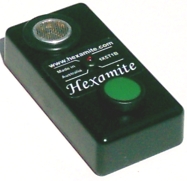 |
|
Ultrasonic Transmitter/Tag with transmission rate control |
| HX5T1 HX5T1 is an asynchronous HX5 ultrasonic tag. The position of the HX5T1 can be monitored and stored by the HX5M1 monitor. The tag transmits localization signals at two rates selected at random. It is battery powered and the lifetime of the battery depends on the average transmission rate or (position update rate). The battery is a commonly available AA size and replaceable. The position update rates can be selected using a membrane push button on the HX5T1. A LED on the tag flashes when the tag transmits. Size 20mm x 80mm x 40mm |
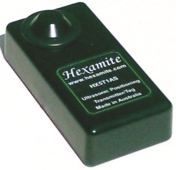 |
|
Tag Sealed Weather tight IP65 compliant |
|
||||||||||||||||||
|
Noise immunity is defined as the sound pressure level of a source located at the same distance from the monitor as the tag and will overwhelm the transmission from the tag to the monitor. Battery Life Expectancy The following graphs show battery life expectancy versus position update rate. A single 3.6V lithium battery 2000mAhrs was used as reference for the graphs. The batteries are replaceable and are shipped with the HX5T1 uninstalled. Batteries for the HX5T1 are available in most places selling electronic components, and can be obtained in the USA at www.mouser.com the mouser part number is 667-TL2100P. The leads must be cut to about 1/3" or 1cm lengths and fitted into the HX5T1 battery socket. Vendors like www.digikey.com, avnet, arrow, allied electronics and etc should also carry similar batteries. In Australia www.jaycar.com.au part number SB-1775. The HX5T1 will run on any batteries supplying 3 to 7 volts.
Position Update Rate control Pressing the membrane push button on the side of
the HX5T1 doubles the average identification and localization rate
(position update rate) as follows: 0.1, 0.2, 0.4, 0.8, 1.6, 3.2, 6.4, 12.8, 25.6, Off (positions/second) |
HX5MT Ultrasonic Transmitter/Tag
|
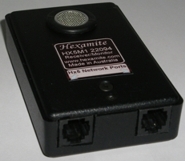 |
|
Figure 1. Hexamite Ultrasonic Position Transmitter or Tag. Size 20mm x 80mm x 40mm |
| HX5MT Ultrasonic Monitor/Receiver
The HX5MT has all the features of the older HX5M1, it also has the main features of the HX5T. It can be set up to be one or the other. The HX5MT replaces the HX5M1, and can operate in asynchronous mode. It can track the position of any HX5T transmitting tags. It can function with the HX5NC network controller, and provide the XYZ coordinate program and other HX5 programs with required data for 3D asynchronous tracking. When the HX5MT is shipped it is configured as a slave for the network controller, no configuration is required for the 3D asynchronous tracking. The HX5MT can also operate as synchronized clusters of tags. This allows the HX5MT to operate with other tags in close proximity without any overrun problems. If plenty of power is available, this feature makes guidance for autonomous apparatus more feasible. |
 |
|
Figure 1. Hexamite Ultrasonic Position Monitor or Tag. Size 20mm x 80mm x 40mm |
| HX5M1 Ultrasonic
Monitor/Receiver HX5M1 is a HX5 ultrasonic monitor, the monitor times and stores the identification of each tag transmitting within it's range. The monitors have RJ11 data ports, the HX5C reads the data from all the monitors on the network through these ports. The data is relayed to a PC through the RS232 port and the position of the tags detected is calculated. Up to 55000 monitors may be connected for wide coverage to a single telephone cable stretching up to 10 km. The HX5M1 has two RJ11 ports; these ports are identical. Two ports are provided to make serial connection of thousands of devices simple. Weather and watertight IP67 versions are available, contact hexamite for more information. |
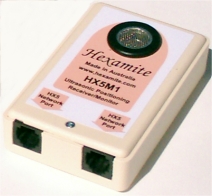 |
|
Figure 2. Hexamite Ultrasonic Position Receiver. Size 20mm x 80mm x 40mm |
|
||||||||||||
HX5C1-RS232 Network Controller The second port connects to the HX5 network at baud rate of 250Kbaud and can drive up to 128 HX5M1 receivers (for more than 128 HX5M1 a repeater is needed). The third port is a serial I/O for developers of HX5. |
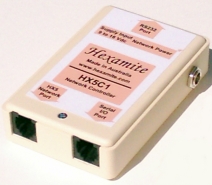 |
|
Figure 1. Hexamite Ultrasonic Position Transmitters/Tags |
|
Size 20mm x 80mm x 40mm The power points on the HX5C are connected to the network power lines via diode, and can serve to supply power to the whole network. There is a ground pin on the HX5C which may be needed to eliminate noise on the network. Note that the network should be grounded in one place close to the PC server. HX5NC-USB Network Controller The HX5NC-USB network controller looks and works like the HX5C-RS232 series controller. It connects directly to the USB port on the computer. Weather and watertight IP67 versions are available, contact hexamite for more information. |
Be aware that telephone lines carry limited amperes and there is a voltage drop in direct proportions to the wire length. In case of long lines, and high number of receivers it may be necessary to use local power for a far away cluster of receivers. HX5R1 Repeater HX5R1 is a repeater, used to boost up power and
communications on the network. Each repeater will drive extra 128 HX5M1
receivers. The repeater also has power points to allow the network power
to be boosted from local power.
|
||||||||||||||||
Standard Ultrasonic Positioning System Test
Kit
For the standard positioning test kit the HX5, the user must obtain some telephone cable and rj11 plugs. The four monitors must be positioned and the position entered into a file called monData.hxm as specified above. The monitors must be connected to the HX5C as shown on the device, and the HX5C connected to the PC. The user must then run the program called xyz.exe, move the tags around and the 3D positioning file will be created. |
| >> |
Copyright © 1999 [Hexamite]. All rights reserved. Revised: December 16, 2016 . |
<< |